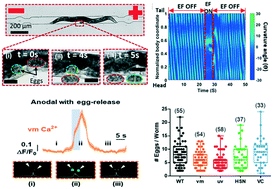Electric egg-laying: a new approach for regulating C. elegans egg-laying behaviour in a microchannel using electric field†
Abstract
In this paper, the novel effect of electric field (EF) on adult C. elegans egg-laying in a microchannel is discovered and correlated with neural and muscular activities. The quantitative effects of worm aging and EF strength, direction, and exposure duration on egg-laying are studied phenotypically using egg-count, body length, head movement, and transient neuronal activity readouts. Electric egg-laying rate increases significantly when worms face the anode and the response is EF-dependent, i.e. stronger (6 V cm−1) and longer EF (40 s) exposure result in a shorter egg laying response duration. Worm aging significantly deteriorates the electric egg-laying behaviour with an 88% decrease in the egg-count from day-1 to day-4 post young-adult stage. Fluorescent imaging of intracellular calcium dynamics in the main parts of the egg-laying neural circuit demonstrates the involvement and sensitivity of the serotonergic hermaphrodite specific neurons (HSNs), vulva muscles, and ventral cord neurons to the EF. HSN mutation also results in a reduced rate of electric egg-laying allowing the use of this technique for cellular screening and mapping of the neural basis of electrosensation in C. elegans. This novel assay can be parallelized and performed in a high-throughput manner for drug and gene screening applications.



 Please wait while we load your content...
Please wait while we load your content...